Women in History: Caroline Chisholm: Australia's first feminist?
Caroline Chisholm (1808–1877) was a British-born Australian immigrant best known for being 'the emigrant's friend'. She earned this title by helping thousands of homeless and unemployed women and families find their feet during the early days of Australian settlement.
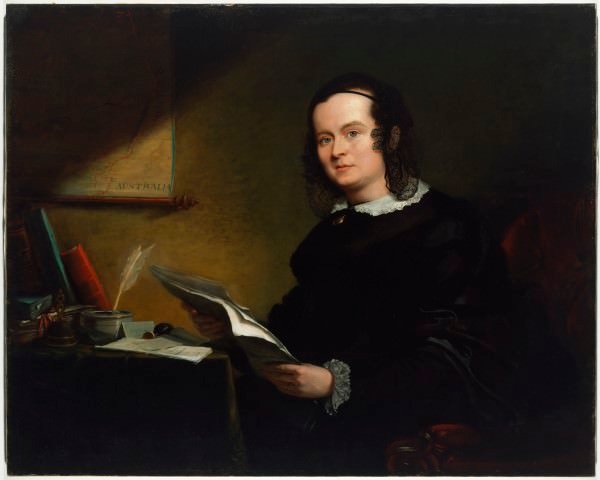
Caroline Chisholm, by Angelo Collen Hayter, 1852. From the State Library of New South Wales.
Caroline's vision for an egalitarian society was far ahead of her time. Her views on women, ethnicity, religion, and possibly even homosexuality (1) were forward-looking and not typical of anyone—let alone women—of her era. She believed in the rights of women and a fair go for all, which underpinned Australia's development as a nation and is still felt today.
Background
Australia's role in European history began in 1788 with the arrival of Captain James Cook and the first fleet. Australia quickly became a purpose-designed penal colony for British criminals. Five years after the first deportation of British convicts, the first fleet of free emigrants arrived, attracted by dreams of a better life (Attar, 2010).
Sometime later, the London Emigration Committee began actively promoting female migration to curb the ever-growing gender imbalance. Single women were enticed with high wages as domestic servants—twice what they could earn in London—and to foster marriages and childbirth (Migration Heritage Center, 2010; Starmans, 2018). Between 1833 and 1837, fourteen ships left Great Britain and Ireland headed for Sydney, Hobart and Launceston, where young women were said to be in high demand.

Source: the State Library of New South Wales
About 4 000 people, 2 700 of which were single women, emigrated to Australia during this time (NFAW, 2009). These girls and women came from workhouses and orphanages in Great Britain and Ireland (Barnett, 1998). The captains of these ships were paid £15 for every fit and healthy female of good character delivered to the colony, and hence they became known as the 'Bounty Girls' (NFAW, 2009). Caroline Chisholm would soon play a huge role in the fate of many of these young women.

Caroline (née Jones) married Archibald Chisholm—a Scottish soldier in the East India Company’s Army—in 1830. However, she rejected his first proposal favouring her career. She also offered him a counter-proposal—she would marry him on the condition that she could pursue her philanthropic goals (Goldman, 2017). This request in itself was unusual as women did not typically have careers, particularly after marriage. He was also unusual, in that he granted her her request.
Two years into their marriage Archibald was posted to Madras, India, which is where Caroline first began engaging in social work. She noticed that the daughters of the European soldiers were at a loose end. Schools had been set up for boys but there was still a lot of resistance to educating girls. Caroline's Female School of Industry for the Daughters of European Soldiers was established based on funding she successfully negotiated from Lieutenant-General Sir Frederick Adams (Goldman, 2017). Her school was unique on two accounts:
- It was a school just for girls.
- These girls were the daughter's of common European soldiers, not British officers and gentlemen (whose children were already taken care of back home).
Caroline began teaching the girls reading, writing and arithmetic, as well as practical domestic skills. Her main goal was to provide them with the skills they would need to earn a living, such as learning how to shop, cook, and manage finances and rations. She also taught them how to be competent mothers, housekeepers and wives, making them suitable marriage candidates. This would hopefully stop them turning to prostitution to make ends meet when they were older (Caroline Chisholm Society, 2017; Goldman, 2017; Iltis, 1966).
Although criticised by modern feminists, it is important to remember that female education was virtually non-existent in the early 19th century (Goldman, 2017). Caroline not only provided these girls with a basic education so they could read and write, but also taught them practical skills that would give them options later in life (Caroline Chisholm Society, 2017; Goldman, 2017).
In 1838 Archibald became ill. He took leave and the Chisholms sailed to Australia, which is where Caroline and her three sons remained when Archibald was recalled to active service in 1840 (Caroline Chisholm Society, 2017; Iltis, 1966). Upon her arrival in Sydney—and thanks to the British Government's migration policies—Caroline quickly noticed that many girls and young women had nowhere to go, no food, and no money (NFAW, 2005). At the time, no support systems were in place to help these 'bounty girls' once they'd disembarked the ships.
Caroline began meeting every immigrant ship that arrived on the wharves. Initially, she began taking homeless girls back to her house, 56km north of Sydney in Windsor (Goldman, 2017; Iltis, 1966). At one point, nine girls were living in her family home.
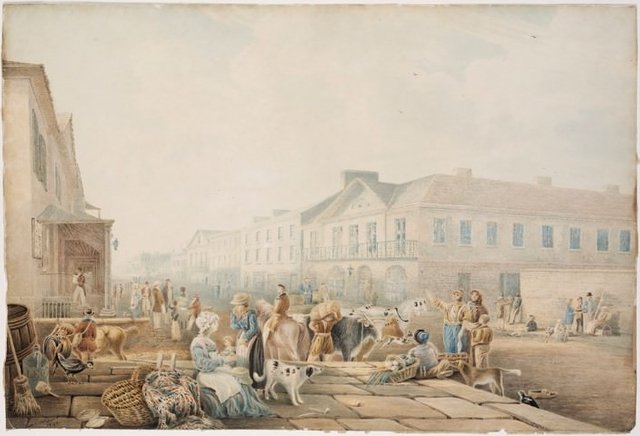
George Street, looking south, Sydney, by Henry Cuzon Allport, 1842. From the State Library of New South Wales.
In January 1841 after Archibald had been recalled to the Army, Caroline approached Governor and Lady Gipps, and the proprietors of the Sydney Herald—John Fairfax and Charles Kemp—with a plan to establish a girls' home. Initially, the Governor held out for religious reasons (2), but Caroline was smart, determined, and already had some experience in negotiations learned from her Indian school. She used the press to her advantage to promote her cause and influence public opinion (Goldman, 2017). Eventually, Governor Gipps granted her a rat-infested, abandoned building in the immigration barracks. It became known as the Female Immigrants' Home, which would eventually house up to 96 girls (Caroline Chisholm Society, 2017; Iltis, 1966).
"...I kept my seat on the bed, reading 'Abercrombie,' and watching the rats until four in the morning: I at one time counted thirteen, and never less than seven did I observe at the dish during the night. The following night I gave them a similar treat, with the addition of arsenic; and thus passed my four first nights at the Home." (Chisholm, 1842).
Caroline had made a large personal sacrifice by giving up her own children—who were back in Windsor—for the seven months she ran the Home (Chisholm, 1842; Goldman, 2017). However, her sacrifice of family over work meant she was able to give protection and shelter to hundreds of vulnerable young women over this period.
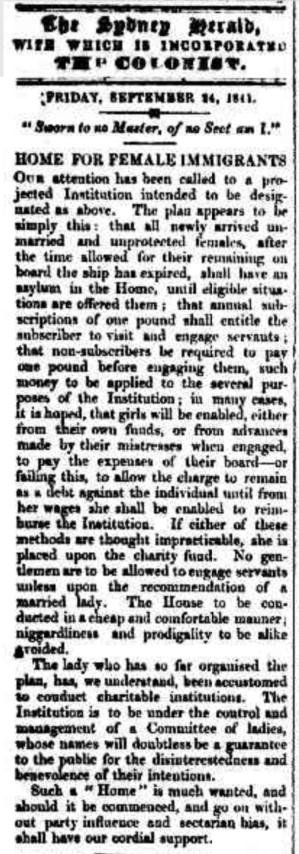
Quote from the article:
The plan appears to be simply this: that all newly arrived unmarried and unprotected females, after the time allowed for their remaining on board the ship has expired, shall have an asylum in the Home, until eligible situations are offered them.
On a shoestring budget comprised mostly of donations, Caroline was responsible for housing, feeding and finding employment for the girls she took in. However, Caroline had a plan. She set up a subscription model to fund the home. She'd already established relationships with numerous farmers and business owners throughout New South Wales and knew which types of servants were in demand and where. For £1 annually, a subscriber could request any number of servants, who would be sent to them at his or her expense (Goldman, 2017).
To ensure the girls were being paid and treated fairly, Caroline wrote up contracts in triplicate for each placement she made. One copy was given to the employer, one to the employee, and she kept a copy in her office. Despite having no legal training, she wrote over 2 000 contracts between 1841 and 1842, and their validity was never questioned in court (Goldman, 2017).
Running a successful retail employment agency was an extraordinary achievement for a woman at that time. By 1842 her program was so successful she had found employment for the entire backlog of girls that she'd taken in (Chisholm, 1842; Goldman, 2017). Caroline, therefore, chose to step away from running the Home. Caroline had also expanded beyond helping the bounty girls to the heads of migrant families, and this became her new focus (IItis, 1966; NFAW, 2005). Between 1841 and 1844 she'd helped over 14 000 people find work, of which 11 000 were newly arrived immigrants (Caroline Chisholm Foundation, 2017; NFAW 2005).
In 1845 Archibald retired from the army and returned to Australia to work with his wife. The Chisholms travelled around New South Wales collecting statements from immigrants about their lives in Australia. This information would later serve as a guide to those in England wanting to emigrate (Goldman, 2017; IItis, 1966).
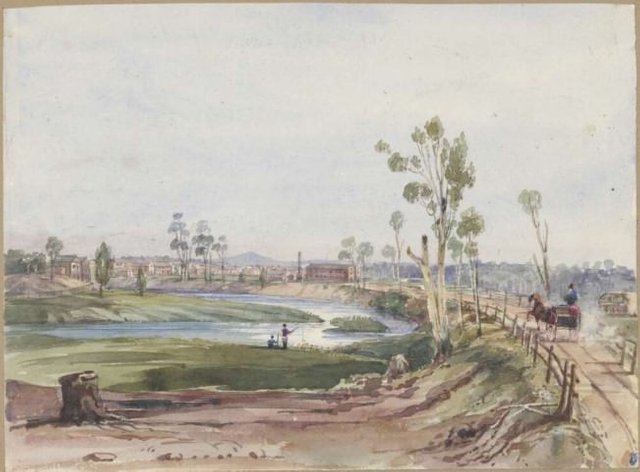
Entrance to West Maitland, by Robert Russell, 1837. From the National Libray of Australia.
In 1846 the Chisholms returned to England, with their fourth son born en route. Of course, being a mother of four did not stop her working. Caroline's activism, energy and experience contributed to changes in the migrant selection process and their reception in the colony. Additionally, the difficulties that she experienced during her trip as a new mother encouraged her to fight for better conditions for migrant women in the overcrowded, dirty ships headed to Australia (Caroline Chisholm Society, 2017; NFAW, 2005).
Caroline was a strong believer in family values and thought this should be the basis of Australia's development. She remained concerned about the high ratio of men to women in the colony and the negative social impacts this could lead to. Her next project was developing a government supported program to send the wives of men already living in Australia, to Australia. Next, she embarked on a project to reunite children who'd been left behind, when convicts and poor migrants had no choice but to emigrate many years before (Caroline Chisholm Society, 2017; Goldman 2017).
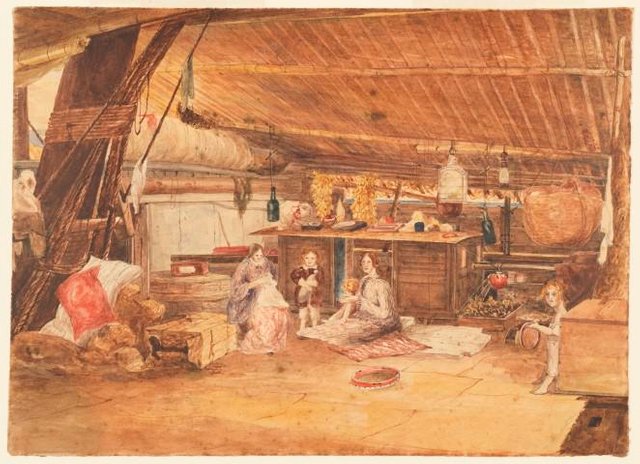
Thornbury family on deck of ship, City of Adelaide. Probably by Nathaniel Henry Thornbury, ca 1881. From the State Library of New South Wales.
Because of her work with the Bounty Girls and families, Caroline was well known throughout Australia. However, by 1852, Caroline had also become one of the most recognised people in Great Britain (Goldman, 2017; NFAW, 2005). Not only did she connect with the wealthy upper class after being invited to give evidence on two immigration committees in the House of Lords—this in itself was rare for a woman—she also connected with the middle and lower classes who her work was aimed at (Caroline Chisholm Society, 2017; Goldman 2017).
Caroline gave birth to two daughters while living in England, before emigrating to Australia again, this time to Victoria in 1854. The gold rush was in full swing and her focus turned to developing 'shelter sheds', which were cheap accommodations for diggers and their families between Melbourne and Bendigo (Caroline Chisholm Society, 2017; IItis, 1966). For health reasons, she returned to Sydney in 1859 and once again found herself pushing society's boundaries by giving public lectures—also rare for a woman. Still passionate about the plight of women, her first lecture covered two sensitive topics (Goldman, 2017):
- Bequeathing property to married women, since they were still barred from owning or inheriting property in New South Wales. (3)
- Women's suffrage. However, this didn't really gain momentum until Maybanke Anderson became the leader of the women's suffrage and education movement 30 years later.
In 1866 the Chisholms returned to England for the last time to a much quieter life. Caroline died in her London home on 25 March 1877, aged 68. She is buried in her birth town, Nottingham, where 'the emigrant's friend' is inscribed on her headstone (IItis, 1966). News of Caroline's death was widely reported throughout Great Britain and Australia, with almost all newspapers in both countries paying tribute to her (Goldman, 2017).
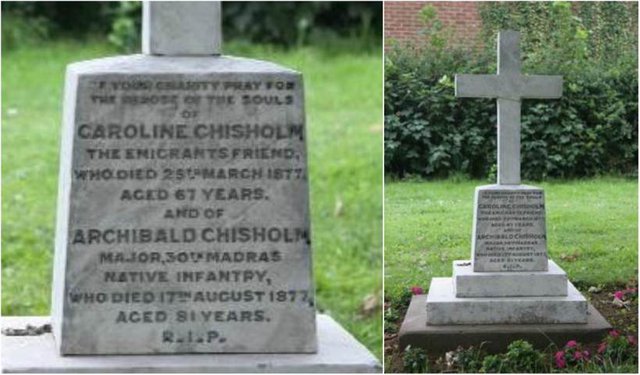
Why did I write this essay?
It's sad for me to admit that Caroline Chisholm is one of the few women that played a significant role in Australia's history that I am familiar with. That said, I don't recall learning about her in school despite seeing her on the five dollar notes throughout my childhood. I only become interested in her in the early 1990s when the old banknotes were to be phased out and replaced by the newer plastic ones. I remember this being quite controversial, given she was one of only two women that appeared on Australian banknotes at the time. However, unlike Queen Elizabeth II, who would feature on the new five dollar banknote, Caroline Chisholm was to be dropped altogether. Because of this, I learned that she'd worked with the poor and was a humanitarian during Australia's convict era.
When I saw this writing contest to discuss a historically significant woman, Caroline Chisholm instantly came to mind. As I began researching her, I found myself mesmerised by her story. She broke so many glass ceilings that most women of her era had no chance of getting anywhere near. She was a realist who came up with practical solutions to problems, and her gender never got in the way. Furthermore, she did not seem to struggle with finding a work/life balance, nor having a non-traditional female role for most of her adult life. In fact, she spent long periods of time away from both her children and her husband so that she could concentrate solely on her work. She skillfully used the tools and resources available to her at the time—most notably the press—as well as her relationships with influential people to get the policy changes she wanted. This ultimately helped thousands of poor people, many of whom were women.
After spending a few days reading about Caroline, I am in awe of her accomplishments (only some of which I've touched on), and the impact that she had on women across three continents and on Australia as a whole. It's hard to imagine that Caroline's legacy didn't substantially influence Australia's development given her selflessness towards helping those in need and her egalitarian principles.
"If Captain James Cook discovered Australia, if John MacArthur planted the first seeds of its extraordinary prosperity—if Ludwig Leighhardt penetrated and explored its before unbeknown interior—CAROLINE CHISHOLM has done more: she has peopled—she alone has colonised it in the true sense of the term." Henry Parkes, Empire Newspaper, 15 August 1859.
How is Caroline Chisholm remembered in Australia?
- A Canberra suburb bears her name.
- A Federal electorate bears her name.
- Her portrait appeared on the first Australian $5 note from 1967 to 1992.
- Chisholm College at La Trobe University, Melbourne is named after her.
- She has a memorial seat in Kyneton, Victoria.
- A natural rock monument at Woodend commemorates her.
- An inscription on a memorial stone at Essendon commemorates her.
- A memorial plaque in Burston Reserve (opposite St Patrick’s Cathedral in Melbourne) commemorates the centenary of her death (Caroline Chisholm Society, 2017).
In addition to this list, various schools, buildings and health facilities around the country bear her name (Iltis, 1966).
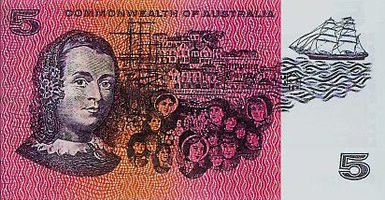
Final word count: 2 215
Endnotes
1) Upon her return to England in 1846, there ratio of males to females in Australia was still a problem. Caroline detailed the effects of this in a letter to Earl Grey:
"the gradual but certain extermination of those unfortunate tribes, the Aborigines of New Holland;...the solitary and cheerless Hut of the unfortunate Emancipist living alone, or at times find two young men associated together".
Goldman (2017) notes that two things stand out here. First, it was highly unusual for white people—particularly white women—to consider the effects of colonisation on Indigenous cultures. Second, the lack of offence she took to possible homosexuality, which was still punishable by death at the time. Later, when she was living in Victoria, Caroline also spoke out on the anti-Chinese legislation, which was presumably a precursor to the White Australia Policy.
(2) The biggest opponents to the girls' home were the local religious leaders, who saw her plan a threat to their congregations (Goldman, 2017).
(3) The Married Women’s Property Act passed into legislation in New South Wales in 1879.
References
Attar, R. (2010), Convicts and colonisers: the early history of Australia, History Extra. Available at: https://www.historyextra.com/period/convicts-and-colonisers-the-early-history-of-australia/. Accessed 28/3/2018.
Barnett, H. (1998), Introduction to Feminist Jurisprudence. University of London. Available at: https://books.google.com/books/about/Introduction_to_Feminist_Jurisprudence.html?id=TrJfXvfWc2YC. Accessed 30/3/2018.
Chisholm, C. (1842), Female immigration considered in a brief account of the Sydney Immigrants' Home, University of Sydney Library, Scholarly Electronic Text and Image Service, Sydney. Available at: http://adc.library.usyd.edu.au/data-2/chifema.pdf. Accessed 28/3/2018.
Caroline Chisholm Society (2017), Caroline Chisholm (1808–1877). Available at: http://caroline.org.au/about-caroline-chisholm/. Accessed 28/3/2018.
Goldman, S. (2017), Caroline Chisholm: An Irresistible Force. HarperCollins Publishers, Sydney, Australia.
Iltis, J. (1966), 'Chisholm, Caroline (1808–1877)', Australian Dictionary of Biography. National Centre of Biography, Australian National University. Available at: http://adb.anu.edu.au/biography/chisholm-caroline-1894/text2231. Accessed 29/3/2018.
Migration Heritage Centre (2010), 1830–1840s Assisted Migration Introduced. Available at: http://www.migrationheritage.nsw.gov.au/exhibition/objectsthroughtime-history/1830-1840s/index.html. Accessed 28/3/2018.
NFAW (2005), Chisholm, Caroline (1808–1877). The National Foundation for Australian Women. Available at: http://www.womenaustralia.info/biogs/AWE1145b.htm. Accessed 29/3/2018.
NFAW (2009), Female Emigration to Australia. The National Foundation for Australian Women. Available at: http://www.womenaustralia.info/biogs/AWE4109b.htm. Accessed 29/3/2018.
Starmans, B. (2018), Female Emigration to Australia 1833–1837. Available at: http://www.thesocialhistorian.com/female-emigration-australia/. Accessed 28/3/2018.
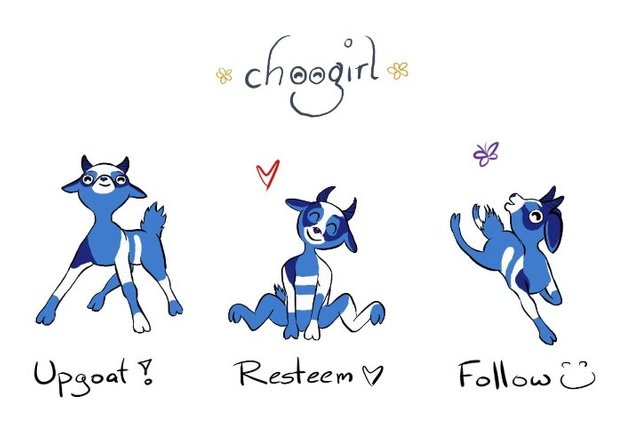
Footer by @ryivhnn
Fabulous post. I have heard of her name but didn’t know her story. I’m guilty of not taking enough interest in Australia’s history beyond high school. I didn’t know about her inspiring story and what a champion she was to women and the poor. My family are immigrants of the Vietnam war in the 70s and I’m grateful here was where we ended up. I love Australia. It was wonderful to read a piece showcasing a familiar name I read in the passing on buildings and plaques and getting a bit of education of their namesake. Had a reminiscent moment seeing the old $5 too. They should have continue with her image because she is an important part of our history worth remembering.
This is a really great write up Chooy. I really had no idea of who she actually was.
And these feminazi's really are the next level of psycho with regards to referencing. I don't think I've seen an article more referenced on steemit, apart from maybe Lord Pervy's articles.
Thanks Gohba, and I appreciate your support on that.
You know I was just here Grading your entry using our rubrik and noting what I liked about it. I was rereading to be sure I was fair even though you weren't too nice when we merely asked you to make your direct quote more clear... and then i see that you got on me about extending the deadline and also said thanks to a guy who called us feminiazis and psycho for kindly asking you to be obvious about your citation.
So i have some thoughts
I'm not sure I understand why you care about our contest or feminist efforts anywhere if you support this behavior in men. We certainly wouldnt stand for anyone to say that about you.
I wonder, if we were men, would you have responded in this way by such a small and very kind request? Who enters a contest and then tears diwn the judges for asking for further clarification?
Why? Just why.
Because feminism is a toxic female supremacy movement.
That's how you define a group for an identity politics block that already has more rights than average, and still agitates for more. A supremacy group.
English definitions here, not an opinion. That's how language works.
Also, you are toxic as hell. Still. Big surprise there. Your entire response is gender-baiting.
You have divided the world up into two teams based on gender. Your team, and everyone else.
So I have some thoughts as well. Why do you instantly think I am a guy? Is it because Sisters HAVE to stick together, women can't speak up against the hypocrisy of Feminism, or because I disagreed with your treatment of this very talented writer, and a HIGHLY respected member of the steemit community that I just HAD to be a guy.
Also, you asked for clarification, she gave you clarification as well as reference material to justify her clarification, and because you are SOOO much smarter than all of the other academic people who have written the textbooks on how to reference, you STILL say she is wrong.
And lastly, yeah I still would have called out your BS if you were a guy. I would have used the term douche bag or wanker, but as your a feminist I prefer to use the term Feminazi.
And with all this being said, AS IF you would mark @choogirls article fairly and objectively. She dared to speak out against the almighty GirlPowa (maybe if referencing is so important, spelling should be on that list of values as well)
I look forward to seeing the winner of this little competition, as I'm sure @choogirl is as well, so that she can see how it is that you are supposed to reference an article in your eyes, as obviously EVERYONE else in the academic environment is so obviously wrong.
Its because i looked at your account. True i always hope that its men trashing on us rather than the wimen we work so hard to support. True it does happen. However its obvious from looking at your account that you are a man.
I was only responding based on the link she gave me. That said we asked others to adjust to fit the contest goals and guidelines and most of them had nothing but kind responses and appreciation for creating the contest.truth be told-- im not as serious about plagiarism nor spellling. Im about heart. My favorite entry wont win even though it has the most heart but its fair. Thats how judging works and i support my judges decisions.
I wasnt actually talking to you. I was talking to her. Its pretty obvious you hate us. She, however, entered our contest which supports our goals. Thus the confusion.
Everyone in the academic environment commented on this post? Weird. I must have missed that. It was a small thing because the initial judge liked the post and it looked as though the words were meant to be her own. I have never seen actual quotes cited that way but I never claimed expert.
Its complex that we should use colloqiualisms in one instance and ask for clarity in a kind and completely justified manner that is befitting of a contest entry in the next but I asure you. We are perfectly okay with that.
We do mark divides. We create space and encourage diversity where it is lacking.
People harrass me in my dms for being a feminist and call myself and my volunteers names for creating a contest thats meant to be uplifting. Anti feminist hate is posted on steemit every day.
And yet im the one thats toxic🤷♀️ Weird.
Heres an anology. Lets say an austrailian creates a team for australians. Then they decide to have an account that talks about the awesome ways that australians have changed the past and future. They create a contest.
Then the entrants of the contests disagree with judges. People who are not australians start talking about how aussies are trash and racist or something that might be equally upsetting as being called a feminazi ( which btw is insulting to both feminists and also jews. hitler didn't just have disagreements with contestants.)
Especially he wouldnt have been as kind as we were.
@Limabeing. That Analogy wouldn't really work as us Aussie's are pretty laid back and couldn't really be arsed dreaming up a contest such as that. Truth be told, most of our history is very racist and dominated by convicts, with males dominating the convict numbers too over 6 to 1. I'm not too sure what all the fuss is about, but my thoughts around feminism aren't too dis-similar to @lexiconical's comment above. Believing another race or gender is superior to another is just plain discriminatory and thats all I'll say about that!
? We are just running a contest and asking for something to be clear. Why does that make us "feminazis" or "psycho" ?
Excellent post @choogirl! Very interesting read about a true pioneer of equal rights, not just for women, but for everyone, especially the poor.
Thanks BMJ, you're right, she seemed just as concerned with the poor as she did with women (although the two were not mutually exclusive).
Great post choogirl. I was just looking at my old $5 paper note the other day and then I saw this fantastically researched post. Great referencing too!
Lol. Thank you scooter. I've enjoyed seeing you post all the old notes.
As an American, I have never heard of her. Had you not posted, I still would not have. Thanks for sharing. Interesting contest.
Thanks @coldsteem. It's sad that she is not really mentioned much anymore, given she's no longer on our $5 notes.
I've lived in both countries and never heard of her. People like this amaze me. It's hard enough to do even when you have a lot of influence, but it must have been harder for her not necessarily being taken seriously being a woman.
I didn't realise that she'd spent time back in Britain after being in Australia. In fact, I assumed she was Australian and that she lived in Aus her whole life. I really had no idea about any of her accomplishments to be honest. Now I wish I'd been able to visit her grave when I went to Nottingham a few years ago.
That's a good idea actually. My daughter is visiting family in June and both my daughters were born in Nottingham city hospital. I'll see if she wants to look for the grave. She's got 5 months to kill after all!
Well that probably help pass an hour (including travel time). :)
Hot dam I didn't know any of this. I don't know where to start in my response. In all honesty, being a Melbournian and living here all my life, I never learnt anything about her in school or anywhere else except right here right now on Steemit.
The first thing I thought when I saw her family name was the college. So I wondered whether it was named after her. Then learning the sacrifice she made with her family to be able to help others is astonishing. I do wonder how her kids felt though, it does make me a little sad at the same time. But her husband was also different, he was supportive and not controlling and strict like many men would be during that time even though he was away most of the time. But when he retired he helped out.
Thank you for sharing this history lesson with us. It was a long read but informative. At one point I was questioning whether Caroline was even human to be able to do all of this and have that many children.
Thanks @supersoju. She actually had eight pregnancies but two of her kids died. She also spent more time away from her husband when he was called away to the Army, I just haven't discussed it here since it wasn't overly relevant to my discussion. My understanding is, her children were fine with her not being around for chunks of time. There is no indication in any text that she was estranged from any of them. In fact, there was a family business in Victoria involving a couple of them who were adults during the gold rush.
Ahhh I see. Thanks for clarifying.
I had no idea of how much Caroline Chisholm had achieved, and really only knew her as the $5 note lady. Thank's for posting such a great, well-researched article Choogirl.
Thank you Terry. That really means a lot to me coming from you.
This is the greatest thing to read tbh and the entire purpose of the contest. Super happy to read this.
Wow! What a woman! Sometimes you read about people and you just sorta feel like, crap, wtf am I doing with my life when one person can make that much of a difference! Better get off my ass :) This was really well written, researched and cited. What a fantastic post. Resteemed :) Much love - Carl
Oh why thank you! That means a lot. She was pretty awesome. I enjoyed spending time thoroughly researching her.
What a fireball this lady was :-) Good to see she is recognized/honored in so many ways. A true hero.
Cheers
Indeed she was. Thanks for reading.